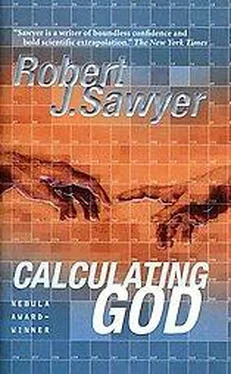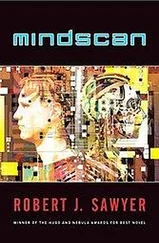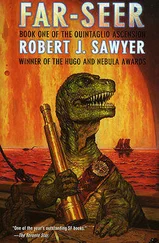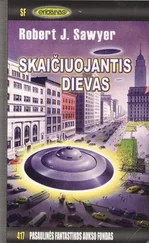Robert Sawyer - Calculating God
Здесь есть возможность читать онлайн «Robert Sawyer - Calculating God» весь текст электронной книги совершенно бесплатно (целиком полную версию без сокращений). В некоторых случаях можно слушать аудио, скачать через торрент в формате fb2 и присутствует краткое содержание. Город: New York, Год выпуска: 2000, Издательство: Tor Books, Жанр: Фантастика и фэнтези, на английском языке. Описание произведения, (предисловие) а так же отзывы посетителей доступны на портале библиотеки ЛибКат.
- Название:Calculating God
- Автор:
- Издательство:Tor Books
- Жанр:
- Год:2000
- Город:New York
- ISBN:нет данных
- Рейтинг книги:5 / 5. Голосов: 1
-
Избранное:Добавить в избранное
- Отзывы:
-
Ваша оценка:
- 100
- 1
- 2
- 3
- 4
- 5
Calculating God: краткое содержание, описание и аннотация
Предлагаем к чтению аннотацию, описание, краткое содержание или предисловие (зависит от того, что написал сам автор книги «Calculating God»). Если вы не нашли необходимую информацию о книге — напишите в комментариях, мы постараемся отыскать её.
Calculating God — читать онлайн бесплатно полную книгу (весь текст) целиком
Ниже представлен текст книги, разбитый по страницам. Система сохранения места последней прочитанной страницы, позволяет с удобством читать онлайн бесплатно книгу «Calculating God», без необходимости каждый раз заново искать на чём Вы остановились. Поставьте закладку, и сможете в любой момент перейти на страницу, на которой закончили чтение.
Интервал:
Закладка:
Robert J. Sawyer
Calculating God
AUTHOR’S NOTE
The Royal Ontario Museum really exists, and, of course, it has a real director, real curators, real security guards, and so on. However, all the characters in this novel are entirely the product of my imagination: none of them are meant to bear any resemblance to the actual people who currently hold or in the past have held positions at the ROM or any other museum.
COMPLETE FOSSIL SKELETONS ARE RARELY FOUND. IT IS PERMISSIBLE TO FILL IN MISSING PIECES USING THE RECONSTRUCTIONIST’S BEST GUESSES, BUT, EXCEPT FOR DISPLAY MOUNTS, ONE MUST CLEARLY DISTINGUISH THOSE PARTS THAT ARE ACTUAL FOSSILIZED MATERIAL FROM THOSE THAT ARE CONJECTURE. ONLY THE AUTHENTIC FOSSILS ARE TRUE FIRST-PERSON TESTIMONY OF THE PAST; IN CONTRAST, THE RECONSTRUCTIONIST’S CONTRIBUTIONS ARE SOMETHING AKIN TO THIRD-PERSON NARRATION.
— Thomas D. Jericho, Ph.D., in his introduction to Handbook of Paleontological Restoration (Danilova and Tamasaki, editors)1
I know, I know — it seemed crazy that the alien had come to Toronto. Sure, the city is popular with tourists, but you’d think a being from another world would head for the United Nations — or maybe to Washington. Didn’t Klaatu go to Washington in Robert Wise’s movie The Day the Earth Stood Still?
Of course, one might also think it’s crazy that the same director who did West Side Story would have made a good science-fiction flick. Actually, now that I think about it, Wise directed three SF films, each more stolid than its predecessor.
But I digress. I do that a lot lately — you’ll have to forgive me. And, no, I’m not going senile; I’m only fifty-four, for God’s sake. But the pain sometimes makes it hard to concentrate.
I was talking about the alien.
And why he came to Toronto.
It happened like this . . .
The alien’s shuttle landed out front of what used to be the McLaughlin Planetarium, which is right next door to the Royal Ontario Museum, where I work. I say it used to be the planetarium because Mike Harris, Ontario’s tightfisted premier, cut the funding to the planetarium. He figured Canadian kids didn’t have to know about space — a real forward-thinking type, Harris. After he closed the planetarium, the building was rented out for a commercial Star Trek exhibit, with a mockup of the classic bridge set inside what had been the star theater. As much as I like Star Trek, I can’t think of a sadder comment on Canadian educational priorities. A variety of other private-sector concerns had subsequently rented the space, but it was currently empty.
Actually, although it was perhaps reasonable for an alien to visit a planetarium, it turned out he really wanted to go to the museum. A good thing, too: imagine how silly Canada would have looked if first contact were made on our soil, but when the extraterrestrial ambassador knocked on the door, no one was home. The planetarium, with its white dome like a giant igloo, is set well back from the street, so there’s a big concrete area in front of it — perfect, apparently, for landing a small shuttle.
Now, I didn’t see the landing firsthand, even though I was right next door. But four people — three tourists and a local — did get it on video, and you could catch it endlessly on TV around the world for days afterward. The ship was a narrow wedge, like the slice of cake someone takes when they’re pretending to be on a diet. It was solid black, had no visible exhaust, and had dropped silently from the sky.
The vessel was maybe thirty feet long. (Yeah, I know, I know — Canada’s a metric country, but I was born in 1946. I don’t think anyone of my generation — even a scientist, like me — ever became comfortable with the metric system; I’ll try to do better, though.) Rather than being covered with robot puke, like just about every spaceship in every movie since Star Wars, the landing craft’s hull was completely smooth. No sooner had the ship set down than a door opened in its side. The door was rectangular, but wider than it was tall. And it opened by sliding up — an immediate clue that the occupant probably wasn’t human; humans rarely make doors like that because of our vulnerable heads.
Seconds later, out came the alien. It looked like a giant, golden-brown spider, with a spherical body about the size of a large beach ball and legs that splayed out in all directions.
A blue Ford Taurus rear-ended a maroon Mercedes-Benz out front of the planetarium as their drivers gawked at the spectacle. Many people were walking by, but they seemed more dumbfounded than terrified — although a few did run down the stairs into Museum subway station, which has two exits in front of the planetarium.
The giant spider walked the short distance to the museum; the planetarium had been a division of the ROM, and so the two buildings are joined by an elevated walkway between their second floors, but an alley separates them at street level. The museum was erected in 1914, long before anyone thought about accessibility issues. There were nine wide steps leading up to the six main glass doors; a wheelchair ramp had been added only much later. The alien stopped for a moment, apparently trying to decide which method to use. It settled on the stairs; the railings on the ramp were a bit close together, given the way its legs stuck out.
At the top of the stairs, the alien was again briefly flummoxed. It probably lived in a typical sci-fi world, full of doors that slid aside automatically. It was now facing the row of exterior glass doors; they pull open, using tubular handles, but he didn’t seem to comprehend that. But within seconds of his arrival, a kid came out, oblivious to what was going on at first, but letting out a startled yelp when he saw the extraterrestrial. The alien calmly caught the open door with one of its limbs — it used six of them for walking, and two adjacent ones as arms — and managed to squeeze through into the vestibule. A second wall of glass doors faced him a short distance ahead; this air-lock-like gap helped the museum control its interior temperature. Now savvy in the ways of terrestrial doors, the alien pulled one of the inner ones open and then scuttled into the Rotunda, the museum’s large, octagonal lobby; it was such a symbol of the ROM that our quarterly members magazine was called Rotunda in its honor.
On the left side of the Rotunda was the Garfield Weston Exhibition Hall, used for special displays; it currently housed the Burgess Shale show I’d helped put together. The world’s two best collections of Burgess Shale fossils were here at the ROM and at the Smithsonian; neither institution normally had them out for the public to see, though. I’d arranged for a temporary pooling of both collections to be exhibited first here, then in Washington.
The wing of the museum to the right of the Rotunda used to contain our late, lamented Geology Gallery, but it now held gift shops and a Druxy’s deli — one of many sacrifices the ROM had made under Christine Dorati’s administration to becoming an “attraction.”
Anyway, the creature moved quickly to the far side of the Rotunda, in between the admissions desk and the membership-services counter. Now, I didn’t see this part firsthand, either, but the whole thing was recorded by a security camera, which is good because no one would have believed it otherwise. The alien sidled up to the blue-blazered security officer — Raghubir, a grizzled but genial Sikh who’d been with the ROM forever — and said, in perfect English, “Excuse me. I would like to see a paleontologist.”
Raghubir’s brown eyes went wide, but he quickly relaxed. He later said he figured it was a joke. Lots of movies are made in Toronto, and, for some reason, an enormous number of science-fiction TV series, including over the years such fare as Gene Roddenberry’s Earth: Final Conflict, Ray Bradbury Theater, and the revived Twilight Zone. He assumed this was some guy in costume or an animatronic prop. “What kind of paleontologist?” he said, deadpan, going along with the bit.
Читать дальшеИнтервал:
Закладка:
Похожие книги на «Calculating God»
Представляем Вашему вниманию похожие книги на «Calculating God» списком для выбора. Мы отобрали схожую по названию и смыслу литературу в надежде предоставить читателям больше вариантов отыскать новые, интересные, ещё непрочитанные произведения.
Обсуждение, отзывы о книге «Calculating God» и просто собственные мнения читателей. Оставьте ваши комментарии, напишите, что Вы думаете о произведении, его смысле или главных героях. Укажите что конкретно понравилось, а что нет, и почему Вы так считаете.











